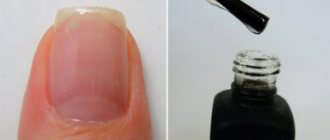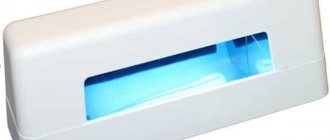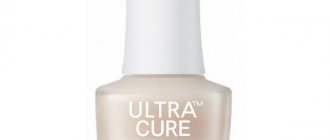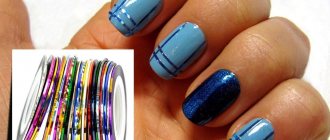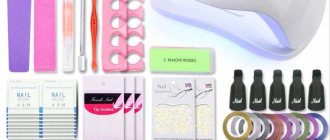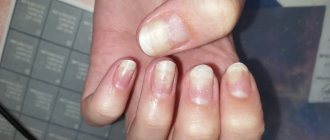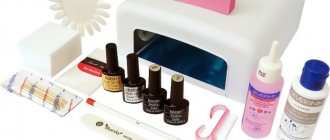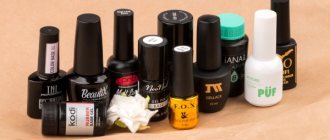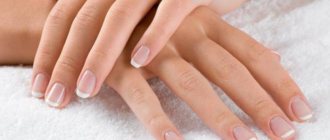Why does gel polish flake off?
Nowadays there are a huge number of manicure and gel polish techniques. In most cases, the master suggests strengthening and leveling with a base. This is suitable if the nails are by nature quite strong, durable, hard and hold the material well. However, this is not always the case.
Why does gel polish flake off:
- In some cases, the plate is soft, thin and very similar to paper or napkin. It is difficult to strengthen such nails with a base. Despite the fact that the Nail industry now offers a huge amount of materials for both thin and durable plates, even a very hard and hard base cannot cope with thin and flaky nails.
- The fact is that if thin, bendable nails are covered with a soft and plastic base, then the coating will move along with the nail plate. In turn, because of this, the natural plate will peel off from the artificial material from underneath.
- Thus, you should not expect the coating to last for three weeks. Usually gel polish comes off like a film on such nails in just a week. If a rigid base is used, then as a result of the mobility of the natural plate, chips will appear on the coating over time. It will come off the plate, but in pieces, not in whole layers.
Peeling nails
Why do nails peel under gel polish?
Don't blame the technician for not being able to take the coating off for even a week. The properties of your own natural plate are of great importance. If it is very soft and mobile, then no base will stick to such nails. There are other reasons why nails peel under gel polish. Below we will look at the most popular of them.
Why do nails peel under gel polish:
- Improper preparation of the nail plate. The fact is that most craftsmen make one main mistake - they do not remove the natural gloss from the surface, but try to file off the plate as much as possible, moving the file in different directions. In fact, it is best to move the file in one direction.
- Insufficient defatting. Many masters believe that it is not worth using an acid primer when coating with regular base and gel polish. In fact, it all depends on the nail plate. If before this a cream was applied, or some work was performed involving fatty, oily substances, then it makes sense to thoroughly degrease the nail plate with alcohol, and apply a dehydrator and primer several times. In turn, this will help to completely remove fat and all debris from the nail plate, which can cause detachments.
- Very wet hands. Indeed, there is a wet nail plate, for which it is not enough to go through a dehydrator once. In this case, on capricious hands, the nail plate is treated with a dehydrator and primer several times. Some masters do this up to 5 times. This allows you to completely dry the nail plate and prepare it for coating.
- Very weak, thin nails. On weak thin plates, even coating with a hard, hard, high-quality base will not adhere well. Therefore, in this case, it is necessary either to completely cut off the free edge, while leaving the nails uncovered, waiting for fusion, or to perform extensions, covering the nail plate with a hard material, with cutting out the natural nail.
Detachments
Do nail baths daily
Procedures with it can be done on a daily basis. For a glass of warm water you will need a tablespoon of salt. Dip your fingertips into the solution so that it covers the nails completely. The duration of this procedure is from 15 to 20 minutes. Afterwards you can apply a nourishing cream. Please note that salt baths are not recommended if there are injuries on your hands: for example, hangnails or wounds.
Another option for baths to strengthen nails is with herbal decoctions. Use pharmaceutical products from chamomile, mint, linden, oak bark. They are usually sold in the form of filter bags. They need to be poured with boiling water according to the instructions on the package and left to steep for 15-20 minutes. Then the resulting decoction is diluted with boiled water and the procedure is carried out.
Why do my nails peel off after gel polish?
In fact, gel polish cannot cause nail splitting. The main reason is the incorrect action of the master, that is, incorrect removal of the material.
Why do nails peel after gel polish:
- This is usually encountered by girls who apply gel polish at home on their own. This means that in most cases, in the absence of a router, gel polish is removed using acetone-containing liquids.
- They destroy the nail plate, fluff up the scales, making the nails flaky. Therefore, the easiest option to avoid peeling nails under gel polish is to use a device rather than a remover.
- For these purposes, a router is usually used and after covering the nails with gel polish, if necessary, remove it, the material is ground down to the base. That is, the base itself, the base remains on the plate and is not removed. A thin layer of it remains as a substrate.
- If you do everything correctly and do not remove the material down to the natural nail, along with its top layer, then the plates will not peel off. If they peel, regardless of whether there is gel polish on them or not, then such a nail plate is considered to be problematic.
- Subsequently, when applying gel polish, difficulties will arise: chips, detachments, and peeling nails under the thickness of the artificial material.
Removable with film
Try sealing your nails
The procedure involves applying wax or biogel to the nails and is carried out by cosmetology specialists. It takes about 40 minutes and can improve the condition of your nails from the first use.
They do it like this: they treat the nail and do a manicure without coating. Then the nail plate is leveled using a fine file. Afterwards, a wax-based product is rubbed into the nail and the procedure is completed by applying nourishing oil.
Since the nail heats up during the sealing process, beneficial substances are absorbed into it better and create a protective film.
There are methods for sealing your nails at home, but we don't recommend it. Incorrect technique can aggravate nail splitting and harm overall nail health.
Nails peeling off under gel polish - what to do?
The ideal option is to use a more rigid material, which serves as a reinforcing layer and strengthens the plate, preventing it from bending and moving. Accordingly, the ideal option would be to strengthen nails with gel, polygel, or acrylic.
Nails peel under gel polish, what to do:
- In this case, the material is applied to the surface of the natural nail, after which a coating is applied. However, even if everything is done correctly, under hard and tough material, soft natural nails can begin to flake and flake off from the artificial material.
- There is no need to be upset, there is a solution. In this case, after applying an artificial coating to the nails, that is, a hard material such as gel, polygel or acrylic, the master uses a cutter to cut out the natural plate, leaving only the artificial material at the end.
- It is not always necessary to cover your nails with artificial material, strengthening them with acrylic or gel. Now there is a lot of information that gel polish harms natural nails, making them thin and vulnerable, peeling.
Detachments from the end
The main reasons for gel polish peeling
There are many reasons why gel polish does not stay on nails. However, often everything depends on the professionalism of the master. If the application technology is not followed, the gel polish will peel off as a film from the entire nail or simply peel off at the edges.
In addition, these reasons may lie in certain characteristics of the body. All this must be taken into account. This is the only way to obtain a durable and reliable coating.
How to apply gel polish on peeling nails?
On top of the layer of such a base is applied a layer of a more rigid one, that is, one that does not bend. In this case, the material in the middle, that is, the movable base, will serve as a kind of layer between the natural nail and the artificial gel polish coating. This can inhibit the appearance of detachments and peeling nails.
How to apply gel polish on peeling nails:
- Be sure to apply dehydrator and primer to your nails several times during the preparation process. If your nails are very capricious, use an acidic primer. Despite the harm, it still has a better effect on the nail plate and promotes better adhesion of the artificial material to the natural nail.
- Be sure to use a bonder that glues the artificial nail to the natural one. It acts on the principle of adhesive tape and has a sticky base, both on the side of the nail and the artificial material.
- After a manicure, if it’s not your first and the plate still peels off from the gel polish, you should cut out the free edge.
- If all the tips did not help, the nails continue to peel off from the artificial material and peel off underneath it, the only possible option is to cover it with hard gel, polygel, or acrylic and cut out the natural nail.
- Please note that this is best done using a ceramic needle or spruce cutter. It is better not to use carbide cutters for cutting out natural nails, as they heat up during operation, which can cause additional detachments. The plate heats up, and so does the material, and it peels off.
Crack in the center
In what cases is it not recommended to wear gel polish?
You just cured nail fungus
- A medicated coating is perfect for you, but not a permanent manicure using gel polish. The varnish can cause damage to the nail plate, which was cured of fungus just a few days ago. If you don’t want the situation to repeat itself, limit yourself to regular or special varnishes.
- There are several types of medicated nail polishes. For example, a strengthening coating will create an invisible film on the nail plates, on which you can apply regular colored varnish. The coating, designed to combat yellowness, has a large number of healing elements. It can help if even vitamin complexes cannot cope with the problem.
- After treatment for fungus, your doctor should advise measures to take to prevent recurrence. Usually this includes giving up gel polish for a while. However, you can do the manicure yourself. The European unedged method is suitable - it is the least traumatic. There are no mechanical actions on the part of special manicure tools or apparatus, the cuticle is not damaged - the nails can be renewed day by day despite the presence of a therapeutic coating.
One of the nails was ingrown
- And when you had to remove it. In most cases, the procedure for removing an ingrown nail involves cutting off only the edge of the entire plate and applying sutures to prevent relapses. If the ingrown toenail was on your toenail (such problems are very rare on the hands), you will have to use a nail extension procedure to restore its appearance.
- Do not extend your nails immediately after surgery. Firstly, for about a week after removing the nail and removing the stitches from your finger, you should not have a pedicure (or manicure). Secondly, let the seam heal: do not try to remove the cuticle in any way yourself or from a specialist. And only after two to three weeks you will be able to go for a pedicure or manicure again. At the same time, a therapeutic coating (which can also be strengthening) is mandatory!
Nails are very peeling
- If you apply gel polish to peeling nails, they simply won’t last long. The coating will come off the nail plate within a few days after application (even if strengthened with acrylic powder). Therefore, you will need to undergo a course of nail treatment and only then do a coated manicure again.
Why can’t gel polish be applied to peeling nails?
The scales of the plate will slowly move away from each other just under the coating. If it is medicinal, the nail will be sealed, but a regular strengthening gel will not help improve the situation. Therefore, do not risk the health of your nails and read materials on how you can quickly and painlessly give your nails a healthy look, and then heal them from the inside.
In this situation, vitamin complexes with calcium, vitamins E and B5 will help. If we talk about medicinal products, use special varnishes that need to be applied closer to the cuticle, and oils that care for the skin at the base of the nail. They will help improve your nails.
Nails are too brittle
Thin nail plates tend to break. Therefore, instead of once again asking the master to strengthen your nails, fill microcracks with acrylic composition and cover the plates with colored shellac, ask about the benefits of a therapeutic coating in your situation. A competent manicure and pedicure specialist will be able to advise the most suitable healing product, which will most likely be in the master’s arsenal.
If your master cannot find the best remedy to solve your problem, refer to our material, in which we described in detail the best means to eliminate nail problems.
Nails covered with white spots
- The most striking signal of problems in the body is white spots appearing on the nail plates. A deficiency of certain vitamins and calcium can also manifest itself in a similar form. If you find small white spots on your nails, start taking special vitamin complexes and do not use gel polish.
- A good treatment option may be a coating that cannot be removed from the nails. A similar varnish is applied to the nail plates and fixed close to the cuticle. Then you don’t need to try to remove or file it off - the transparent varnish will grow back along with the nail, and the grown edge can be carefully filed down every few days. During the time until the nails are completely renewed, the varnish will have time to act on the plates and saturate them with useful elements.
There are cracks in the nails
- Which can appear both under gel polish and under regular coating without strengthening. The cracks go deep into the nail and do not end at just one grown edge. In this case, you will need strong strengthening of the nail plates - and not shellac on top of a nearly broken nail.
The strengthener must be therapeutic - otherwise it simply will not act on the root of the problem.
- If you want to make an acrylic reinforcement, abandon this idea in favor of a more natural and easily removable coating. Acrylic strengthening is performed on top of the applied transparent gel polish, so this method of solving the problem of cracks on nails is not suitable for us.
Nails cannot “wear” gel polish for a long time
This is a direct consequence of constantly wearing shellac without a break. If you haven't given your nails the proper amount of time to rest, constantly go for manicures or pedicures with gel polish and don't use regular polishes, at some point the plates may simply get tired. In order to revive their ability to wear gel polish for a month and a half, you will need to take a break between manicure or pedicure sessions.
Such a break can last about a month. In any case, it will not be harmful to you - your nails without coating will become healthier, and you will be able to remove the cuticle on your own at least every week. In such a case, manicures and pedicures can be done - it is only important not to overload your nails with excessive layers of gel polish.
Nails extended for medical reasons
If you had to extend your nail on the recommendation of your doctor, it is best to leave this plate uncoated. Limit yourself to strengthening varnish, which can be removed with ordinary liquid without acetone. Or ask for a Japanese manicure and rub the manicure paste into your cuticles to polish your nails and give your hands a more well-groomed look.
Don’t worry - any experienced nail technician can grow a piece of nail the same color as the whole plate. Especially considering the fact that extension pastes come in different colors (even pink).
Be careful about the health of your nails and do not wear gel polish if it is contraindicated for you!
And on our website you can always find interesting materials with step-by-step techniques for safe manicure, advice from experienced industry professionals, and even video tutorials.
Base for peeling nails: list
We advise you to change the base and use not one, but two. At the initial stage, a soft movable base is applied, which bends along with the nail.
Base for peeling nails, list:
- UNO. The rubber base is thick and takes a long time to level out.
- Nano Professional NANLAC Gum . Very thick, takes a long time to level out.
- RIO Profi Rubber. Very thick, does not self-level well.
- Artex. The consistency is medium, it bakes a little at high power.
Varnishes for peeling nails: reviews
If you completely drink the nail and properly prepare the nail plate, the problem will go away. Of course, instead of covering natural nails, you get a kind of extension, but if you want a beautiful manicure, then this option will be an excellent solution. This is a good way to get beautiful, long nails with a very thin, flaky and flexible nail plate.
Varnishes for peeling nails, reviews:
Christina, 41 years old. I often used different bases, but did not always get the desired effect. Sometimes, the base peeled off, the vinyl material or the plate was prepared incorrectly. However, after several such manipulations, I realized that the gel polish was chipping due to the very thin nail plate. Now I cover my nails with gel, and only then I apply gel polish. Unfortunately, the gel nails didn’t hold up well until I started cutting out the free edge.
Elena, 25 years old. I don't know how to do my own coating, so I go to a salon. I found myself a good master not so long ago. Unfortunately, before this, the gel polish peeled off, came off in pieces, and the nails peeled off under the layer of material. I changed the technician, and the situation improved. Now the master uses Uno base for problem nails. Unfortunately, the cost of a manicure with such a base is not the most affordable, but it lasts for 3 weeks.
Svetlana, 30 years old. I am a manicurist, I have been doing nails for 7 years. There are also clients who don’t wear gel polish well. Therefore, after the first visit, if chips, detachments are visible, or the coating comes off like a film, I advise you to cover it with acry-gel. I also have Fast-Gel from Cosmoprofi for particularly problematic nails. With these materials nothing flakes off. However, not everyone agrees, since it is much more expensive than regular base leveling.
Initially, the master, when unfamiliar with the new nail plate, offers the simplest and most inexpensive option, that is, strengthening the nails with a base. When detachments appear, a rigid base or solid material is selected.
